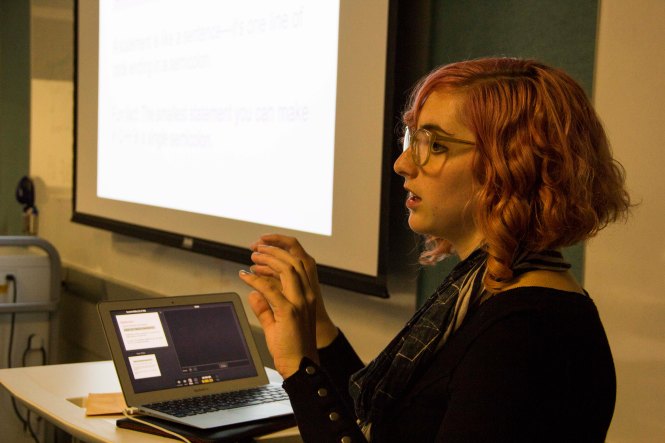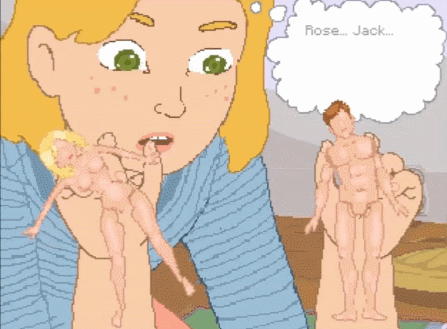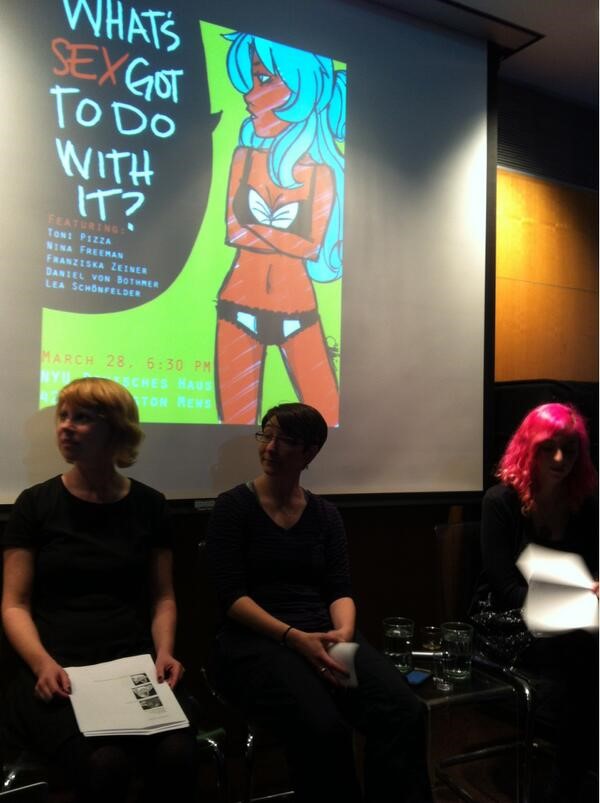Nina Freeman is a game developer currently working at Fullbright as a level designer on the upcoming game Tacoma. She also works actively on personal vignette games, available on NinaSays.so. She is best known for working on games how do you Do It? and Freshman Year, which express her exploration of gender, sexuality, and narrative in games. She is the designer on a team called Star Maid Games, which launched Cibele in November 2015, a game that illustrates her experience falling in love with someone she met through an online game.
NINA FREEMAN Video Game Developer COMPANY Fullbright EDUCATION Pace University - BA English NYU Polytechnic School of Engineering – MS Integrated Digital Media WEBSITES NinaSays.so
What was the online game you played that inspired Cibele?
I played Final Fantasy XI for four years when I was in high school and through early college. Cibele is based on experiences from that time.
When did you first start playing video games?
I was 11 years old when I rushed to Suncoast Video to use up all of my allowance renting Final Fantasy X. I played a ton of Neopets and dabbled in Gaia Online. I think Neopets encapsulated both roleplay games and Tamagotchi for me as a kid. I also taught myself how to design HTML websites using their guild system!
How did you first start making games?
When I was an English major, I mostly studied poetry. After I graduated, I met all these game designers & developers in New York, like Emmett Butler and Diego Garcia, and I saw them making games. I’d just started grad school for “Technology and Science in Literature,” and I was writing a lot about online video games. I watched them make this iOS game called Heads Up! Hot Dogs, and I was like, “WHOA! I didn’t know people could make video games!” I’d never even thought about making video games. It reminded me of poetry and storytelling, so when I saw them doing it, I was like, “I can do that, too.”
Was there a steep learning curve to start making video games? How did you get past that?
Emmett, who I mentioned, helped me a lot in getting started. I had programmed when I was a kid; I had an idea of the basic concepts. I just started hacking on stuff, and I had Emmett as a resource when I had questions. Having a community and people to ask questions to was really helpful.
Why did you throw yourself into game development so fervently?
I had just recently gotten diagnosed with this illness, eosinophilic esophagitis. I really needed the challenge to… not be super depressed. I felt like I wanted a challenge, because being sick was really scary, and it felt like a good thing to sink all my time into. So I decided to go down this new path.
Can you tell me more about the women’s group called Code Liberation Foundation?
I met Phoenix Perry [Code Liberation Founder] at GDC in 2013 before I’d really done anything in games yet. We bonded over the fact that we felt alone because there weren’t any women speaking at the Tech Talks. I told her I was learning how to program, and she was already a professional programmer and a game designer. She lived in New York, so she said we should totally hang out.
We met up again about a month or two later, and she invited a bunch of other New York-based women game programmers. There was me, Catt Small [creator of Prism Shell], Jane Friedhoff [creator of Slam City Oracles], and a few others. The group of us basically met up that night, had pizza, and started talking. “We can all code, but… we don’t have many other women friends in the game scene who are doing programming.”
Phoenix pitched to us her idea of just going and teaching more women, as lady programmers, and that would be how we could get more women into games. We were all interested in doing that. We just started teaching free classes that were women-exclusive out of NYU right away.
It was just us trying to get more women involved in the scene. We figured that the best way for us to do that was through teaching code. And that’s still going strong. I’m pretty proud of that group.
How are you involving women with the gaming community, who otherwise might not become involved on their own?
Phoenix was teaching at NYU at the time, so she talked to them and got us a free space. We just started teaching classes for free to women who wanted to learn how to program. And that actually made me a much better programmer! Having to teach programming is a huge challenge and will make you a better programmer.
We just relied on our social media outlets and word-of-mouth to get people to come to our first class, which was “Intro to C++ Game Programming.” Somewhere around 60 women showed up for the first class! The Code Lib classes are notoriously well-attended now.
Ultimately, people talk about trying to get women into Computer Science all the time, but they don’t do anything about it. They just talk about it. So we were like, “We don’t just want to just talk about it.” It’s easy: you just directly reach out to women, and tell them, “Here’s a free thing. We’re gonna help you learn how to code. All you have to do is show up.” And then people show up, and they do it. That’s it.
I’m not actively involved in Code Liberation anymore, as I have moved to Portland, Oregon to work at Fullbright. The ladies in NYC are still working on it and hosting events! They’re doing very well.

Nina taught high school girls through The Code Liberation Foundation from 2013-2014.
Can you describe your own education?
I lived in New York City in Brooklyn for six years, but I grew up in Massachusetts, in Ipswich, near Boston. I went straight from high school to Pace University for English starting in 2008. I mentioned earlier that I started in that “Technology and Science in Literature” program, but I quickly realized I didn’t want to get a masters in poetry. I left literature and started grad school in Computer Science at Pace University, but that’s when I got sick. About a semester later, I was healthy enough to start grad school anew, and at that point, I’d really gotten into making games. I started at NYU, where I got a masters “Integrated Digital Media” degree.
How do you compare poetry and building a game?
With games, you think about the rhythm and pace, just like with poetry. I think the process is largely the same, except for games have the overhead of writing the code to implement the design you come up with, so there’s sort of a second layer. With poems, you can write it on a notebook, but you have to get it published if you want lots of people to read it. There are lots of layers to each process.
What’s the story behind the making of how do you Do It?
How do you Do It? was a Game Jam game made in three days by me and my friends: Emmett Butler, Decky Coss, and Joni Kittaka. We just decided to go to Global Game Jam 2014.
The night before, Emmett and I were at a bar, and we were telling funny childhood stories to each other. One I always have in my back pocket is about how I used to play “sex” with my dolls.
The summer after I graduated, I wrote this really long poem and put it on GitHub when I was learning to code. That was how I taught myself version control – writing that poem. That little vignette is from that larger poem, and so Emmett and I were talking about how funny it was.
That whole scene was a very physical memory. Playing with dolls itself is a game, so it made a lot of sense that one could make a game around that idea. The next day we found out that the Game Jam theme was, “We don’t see things as they are, we see them as we are.” And I was like “Oh! That’s like exactly what I was doing as a kid; I was projecting myself onto these dolls.” So we decided to do it at the Game Jam.
Decky was there in New York with us, so she came on right away, and Joni was someone we knew through a friend, so she joined us as well, so that’s how it came about.

Play the role of an inquisitive 11-year-old girl whose mother has just stepped out for an errand.
[how do you Do It? gained massive popularity, going on to be an Indie Cade 2014 Finalist as well as an Independent Games Festival Finalist at GDC 2015. Programming and design by Nina Freeman & Emmett Butler. Graphics by Joni Kittaka. Music & sound effects by Decky Coss. It is available on Steam as well as Nina’s website, NinaSays.so/howdoyoudoit. This game was made using Flixel. You can view the Github repository. The music can be found here. It has been mentioned in other press such as the Kotaku watchlist, and Indiestatik.]
Your two best-known games, how do you Do It? and Freshman Year, tackle formative experiences you’ve had with sexuality and femininity. What’s your stance on sex in games?
I’ve spoken quite a bit about sex in games over the past year. Cara Ellison interviewed me and we talked a bunch about sex in my work.
Wired.com interviewed me more directly about sex in games here.
I did a podcast with Tiny Missile, too. Sex is something I think about all the time, so I guess that’s why it comes out of almost everything I do.

Nina Freeman speaks on a panel called “What’s Sex Got to Do with It?” at NYU.
When how do you Do It? first got lots of press coverage, right after we released it for Global Game Jam, I was immediately struck by how shocked everyone was by the game. Reactions were like “Whoa, I can’t believe it’s a little girl thinking about sex! Oh my God!” Some people were scandalized. I want to make games that are personal and honest, but a lot of people aren’t ready for that yet.
Releasing it on Steam just further emphasized that reality. There were Steam reviews that were like, “Ugh, this is so messed up!” or people saying that it’s pornographic (which is ridiculous, because the game is about simple plastic dolls). Some people thought the game was perverse, but most thought it was hilarious.
Talking about sex is generally taboo in America, so I think that that taboo causes a lot of anxiety around when people share personal stories about sex. They’re not used to things that feel really honest and true, like a real human experience, rather than the Hollywood image of what sex is. I think that that is why there is some anxiety around how do you Do It? from people who have experienced this taboo of what happens when you grow up in America.
That’s exactly what this game shows – me only doing this doll-play thing while my mom is out running an errand! And if she comes home and catches you, she freaks out like, “Oh my God! No!” It’s interesting to see the game evoke that anxiety in-game, and also evoke that anxiety outside of it in some players.
I tell honest and raw stories in my games because I came from poetry, and personal vignette poetry is a big thing. That’s what I studied in school! So, it’s there, but it’s just not being done very often in games. It certainly has been done, it’s just not as widely known or accepted yet.
What is something you wish you had done on all your games?
I always wish that I could have had infinite amounts of time to work on each game. There’s always so much I want to do that’s entirely out of the scope of my expertise and time constraints. It’s fine though, because nothing’s ever going to be perfect. I always enjoy moving onto new projects.
How did you get hired at Fullbright?
I had met Steve Gaynor and Karla Zimonja, the Fullbright people, at GDC a couple years ago. We kind of connected about games and discovered we were interested in a lot of similar things, such as more narrative-focused games. So I think it was a pretty natural move for me to try and join them. It’s pretty rare – there aren’t very many studios that I know of that are doing more narrative stuff, so I was super interested in joining them. We talked at GDC, and then they were like, “Okay, when you graduate, let’s try this thing.”
Gone Home had already been released when I first met them. I was showing how do you Do It? and Ladylike at this little party thing at GDC, and Steve was really interested in them. I said “I really love Gone Home!” And at the time, I was starting to work on my current project, Cibele, which has some Gone Home inspirations. We were chatting about that, and I said, “I’d love to tell you more about this game I’m working on and get your opinion,” so we kept in touch through that.
Tell us more about Cibele in your own words.
Cibele was my master’s thesis game. “Star Maid Games” is a team made up of me, Emmett Butler, Decky Coss, Rebekka Dunlap, and Samantha Corey. I started it myself as just a prototype in Bennett Foddy’s prototyping class at NYU. I reached out to a lot of the people that I’d worked with before, and “Star Maid Games” is sort of like our team name for the project. It started out as this solo prototype. But I’m not one to make games alone; I like making them on teams, so I went out of my way to try and find a really good team.
Cibele is about a girl who is in a relationship with a guy in an online game. The game is about how they become close and try to meet up and have sex in real life. And it’s all an autobiographical vignette of this experience that I had when I was around 18 or 19. So yeah, it’s all about online games, and relationships, and sex, and the internet, and stuff like that. [laugh] The game is meant for mature audiences. It’s got picture of folks in their underwear and some swear words, and a focus on sex (but, of course, no actual sex is shown).
Thank you so much for your time, Nina! I hope you continue to inspire more women in game development.
Cibele was released November 2, 2015, and is currently available on Steam for Mac and PC. If you would like to reach out to Nina, She Builds Games, or the Code Liberation Foundation, shoot us a tweet:
She Builds Games @SheBuildsGames | Nina Freeman @hentaiphd | Fullbright’s Tacoma Game @TacomaGame | Fullbright Company @fullbright | Code Liberation Foundation @CodeLiberation

